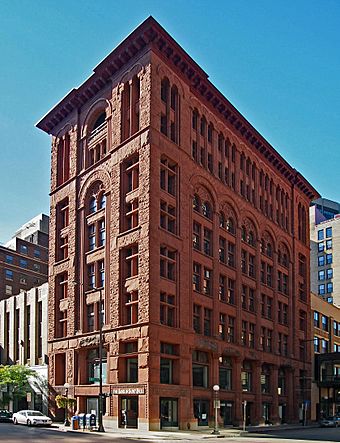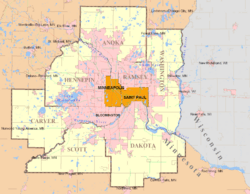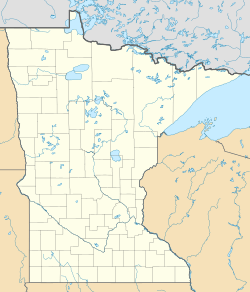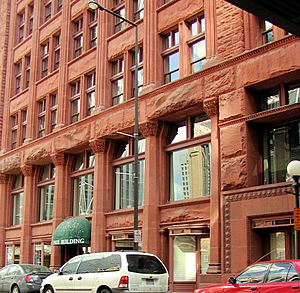Germania Bank Building (St. Paul) facts for kids
Quick facts for kids |
|
|
Germania Bank Building
|
|

The Germania Bank Building viewed from the north
|
|
| Location | 6 5th Street W., Saint Paul, Minnesota |
|---|---|
| Area | Less than one acre |
| Built | 1889 |
| Built by | Lauer Brothers |
| Architect | J. Walter Stevens (architect), Harvey Ellis (designer) |
| Architectural style | Richardsonian Romanesque/Renaissance Revival |
| NRHP reference No. | 77000764 |
| Designated | December 6, 1977 |
The Germania Bank Building, later called the St. Paul Building, is a historic office building. You can find it in downtown Saint Paul, Minnesota. It was built a long time ago, in 1889.
This building is very important for its architecture. It was added to the National Register of Historic Places in 1977. It's special because it's the only tall building made of brownstone left in Saint Paul.
Contents
Building a New Bank
Choosing the Design
In 1884, Saint Paul was a fast-growing city. The Germania Bank was started there. Alexander Ramsey was its president. They needed a new building in a great spot downtown.
They held a contest to find the best design. Eleven different designs were submitted. The judges picked the one from J. Walter Stevens. He was an architect who designed many beautiful homes and warehouses in Saint Paul.
Who Designed It?
J. Walter Stevens learned architecture by working for his father. He became successful with help from talented artists. These artists often moved from city to city. They followed where new buildings were being built.
One of these artists was Harvey Ellis. He was a very skilled architectural artist. He worked for Stevens sometimes after 1886. Some experts believe Ellis helped design the Germania Bank Building. This is the only bank Stevens is known to have designed.
A Unique Look
A drawing of the Germania Bank from 1888 shows its special design. It mixes two popular styles. One is the Richardsonian Romanesque style. The other is the Italian Renaissance revival style for the top floor.
This mix of styles was becoming popular in other big cities. This makes people think that Harvey Ellis, who traveled a lot, helped create the design. At eight stories tall, the building was much higher than its neighbors. It was also the last tall building in Saint Paul made of brownstone.
Building Design and Features
Outside the Building
The building has huge entrances and windows. They are supported by Roman arches. These arches are part of strong walls made of rough, red Lake Superior Sandstone. Stone workers carved amazing designs into the soft sandstone. They decorated the columns, windows, and doors.
The top part of the building has a colorful checkerboard pattern. It also has small columns called colonettes. These were inspired by old Italian palaces. The Lauer Brothers built the structure. It cost more than $165,000 at the time.
Inside the Bank
The bank itself was on the entire second floor. It had a beautiful wooden ceiling with sunken panels. The room also featured detailed carvings and arched spaces. The floors were made of marble. Ornate iron gates were at the tellers' windows.
What the Building Was Used For
Changes Over Time
Just ten years after it was built, the Germania Bank closed down. By 1902, the building was called the Ernst Building. This was after its new owner, Caspar Ernst. Five years later, it became the Pittsburgh Building. In 1934, it was renamed the St. Paul Building.
Who Worked There?
Over the years, many different people had offices in the building. These included doctors, dentists, and lawyers. A dressmaker also had a shop there. The Pinkerton National Detective Agency also had offices.
On the street level, there were shops. You could buy books, gloves, jewelry, cigars, candy, and shoes.
A Famous Writer?
A historian named David Page believes that F. Scott Fitzgerald might have rented a room here. This was in the winter of 1921. Fitzgerald was a famous writer. He kept his location a secret so he could write without being bothered. Soon after, he started writing the short stories that became The Great Gatsby.
Later History and Restoration
Over the years, some of the building's original design was changed. This happened especially after World War II. The storefronts were updated to look more modern.
However, in 1977, the building was listed on the National Register of Historic Places. Then, in the mid-1980s, the storefronts were brought back to their original 19th-century look.





